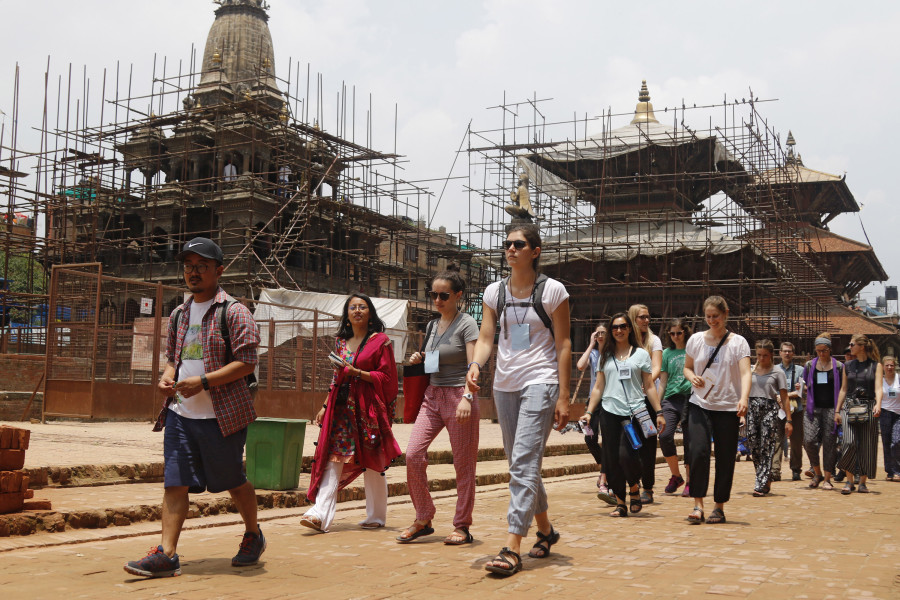Editorial
Fear of Chinese tourists hasn’t killed Visit Nepal
Irrationality must not overpower truth. Visit Nepal’s failures are due to misdirected campaigning.
Nepal’s tourism year campaign for 2020 seems to be bound for failure. The signs towards this outcome came early, when the campaign organisers made many gaffes. That the seat of Nepal Tourism Board CEO stayed empty for much of January should have been a dead giveaway, but the rot set in much earlier. The website for Visit Nepal 2020 did not have any promotional content until at least mid-September, for instance. But it seems that the coronavirus epidemic in China has put the final nail on the coffin of Visit Nepal.
Visit Nepal was always going to suffer if a disease broke out in the neighbourhood. Other countries in Asia and abroad too are suffering from the lack of Chinese tourists. While Nepal was hoping to attract a record 350,000 Chinese tourists this year—bound not to happen now—Thailand is reeling from a tourism crisis, with 9 million less Chinese tourists expected to visit this year. However, what is a one-time, unavoidable stroke of bad luck—global pandemics do not occur on a regular basis, much less consistently near Nepal—reports of discriminatory attitudes against Chinese tourists will threaten to destroy Nepal’s burgeoning tourism sector and set it back by years.
Nepali officials will love to use the Covid-19 outbreak as a reason to mask the failures surrounding Visit Nepal 2020. To be sure, the disease has had a major impact the world over. Tourist arrivals from China for February are already 90 percent lower this year than the same month last year. Since 2012, the Chinese have been the largest contributors to outbound tourism globally. In 2017 alone, Chinese tourists spent $258 billion, around 20 percent of the world’s total spending on tourism that year. Posting such numbers, and with Nepal itself hoping for record arrivals from the northern neighbour, it is logical to assume that with the Chinese staying home, more and more countries will face hardships until the epidemic is contained.
However, the reduction in the numbers of all tourists this year has been painted by some as due to the fear of the Chinese tourists who have shown up to Nepal. This is just a feeble excuse. For sure, some international tourists may have stayed back owing to Nepal’s proximity to the epicentre of the Covid-19 outbreak. But this has nothing to do with the few Chinese tourists that are here. In truth, the biggest issue has been Nepal’s failure to adopt modern, catchy ways to market itself. The country’s tourism promotion bungled from one misdirected attempt to another. The need of the hour was slick advertising campaigns on television and social media. Malaysia, for instance, has gained global recognition and seen tourist numbers greatly increase since the launch of its ‘Malaysia: Truly Asia’ advert campaign in 1998. Similarly, Japan has had great success—and millions of followers—on Instagram due to its #visitjapan campaign. Meanwhile, Nepal had its tourism minister lambasted for showing up to Australia—in the midst of their biggest bushfire crisis—to hold an illegal street rally.
The simple fact remains: Nepal should have done a better job in promoting tourism for this year. That the Covid-19 epidemic has scared away a chunk of the business this year will have no effects in the future of tourism in Nepal. But the lack of effective promotions, the attempted cronyism and interference at Nepal Tourism Board, and the failure to build-up necessary products and infrastructure to attract a wide range of tourists, combined, will surely have detrimental effects on Nepali tourism for many more years to come. Should discriminatory and irrational fears push the sector to reject Chinese tourists in this crucial juncture, that market may not provide tourists in the years to come. In such times of hardship, cooler heads must prevail.
***
What do you think?
Dear reader, we’d like to hear from you. We regularly publish letters to the editor on contemporary issues or direct responses to something the Post has recently published. Please send your letters to [email protected] with "Letter to the Editor" in the subject line. Please include your name, location, and a contact address so one of our editors can reach out to you.




 16.12°C Kathmandu
16.12°C Kathmandu














